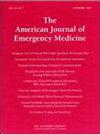Pre-stroke emergency department utilization in the Brain Attack Surveillance in Corpus Christi (BASIC) project
IF 2.2
3区 医学
Q1 EMERGENCY MEDICINE
引用次数: 0
Abstract
Background
Pre-stroke ED visits may represent opportunities for stroke prevention. We evaluated the prevalence and predictors of ED visits in the 90-days preceding a stroke, and the frequency of visits for “high-risk” diagnoses known to be associated with short-term stroke risk, including neurologic symptoms, atrial fibrillation, falls, and hypertensive disorders.
Methods
Within an ongoing population-based stroke surveillance study in South Texas, we identified all physician-validated ischemic and hemorrhagic strokes from April 2003 to December 2020. Linked Medicare claims data were used to identify ED visits in the 90 days before each stroke. Logistic regression was used to evaluate clinical and sociodemographic factors associated with pre-stroke ED utilization. High risk diagnoses were identified by manual review.
Results
A total of 2498 validated stroke cases were matched to Medicare claims data. Patients were 57 % female and 47 % Mexican American with a mean age of 77 (SD 11). A total of 209 patients (8.4 %) had an ED visit in the 90-days before their stroke, including 102 (4.1 %) with multiple visits. Medicaid insurance (OR 1.54, 95 %CI 1.05–2.26) and diabetes (OR 1.73, 95 %CI 1.21–2.47) were associated with greater odds of a pre-stroke ED visit. Of 430 total ED visits, 87 (20.0 %) were for a high-risk diagnosis, including 70 (16.3 %) for a neurologic diagnosis, 12 (2.8 %) for a hypertensive disorder, and 5 (1.2 %) for atrial fibrillation.
Conclusions
Pre-stroke ED visits were common, particularly among patients with diabetes or Medicaid insurance, and were often associated with high-risk primary diagnoses, potentially representing opportunities for stroke prevention or early treatment.
脑卒中前急诊科在科珀斯克里斯蒂(BASIC)脑梗死监测项目中的应用
中风前的急诊科访问可能是预防中风的机会。我们评估了卒中前90天内ED就诊的患病率和预测因素,以及已知与短期卒中风险相关的“高风险”诊断的就诊频率,包括神经系统症状、心房颤动、跌倒和高血压疾病。方法:在南德克萨斯州正在进行的一项基于人群的卒中监测研究中,我们确定了2003年4月至2020年12月期间所有经医生证实的缺血性和出血性卒中。相关的医疗保险索赔数据用于确定每次中风前90天内的急诊科就诊情况。采用Logistic回归评估与卒中前ED使用相关的临床和社会人口学因素。高危诊断是通过人工检查确定的。结果2498例卒中患者与医保理赔数据相匹配。患者57%为女性,47%为墨西哥裔美国人,平均年龄77岁(SD 11)。共有209例患者(8.4%)在卒中前90天内就诊,其中102例(4.1%)多次就诊。医疗补助保险(OR 1.54, 95% CI 1.05-2.26)和糖尿病(OR 1.73, 95% CI 1.21-2.47)与卒中前急诊科就诊的较高几率相关。在430例急诊就诊中,87例(20.0%)为高危诊断,其中70例(16.3%)为神经系统诊断,12例(2.8%)为高血压疾病,5例(1.2%)为房颤。卒中前急诊科就诊很常见,尤其是糖尿病患者或有医疗补助保险的患者,而且往往与高危原发性诊断有关,这可能代表着卒中预防或早期治疗的机会。
本文章由计算机程序翻译,如有差异,请以英文原文为准。
求助全文
约1分钟内获得全文
求助全文
来源期刊
CiteScore
6.00
自引率
5.60%
发文量
730
审稿时长
42 days
期刊介绍:
A distinctive blend of practicality and scholarliness makes the American Journal of Emergency Medicine a key source for information on emergency medical care. Covering all activities concerned with emergency medicine, it is the journal to turn to for information to help increase the ability to understand, recognize and treat emergency conditions. Issues contain clinical articles, case reports, review articles, editorials, international notes, book reviews and more.

 求助内容:
求助内容: 应助结果提醒方式:
应助结果提醒方式:


